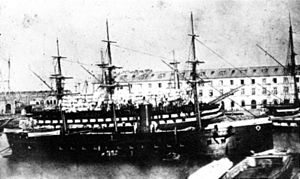 Normandie in the foreground
| |
| History | |
|---|---|
| Name | Normandie |
| Namesake | Normandy |
| Ordered | About September 1858 |
| Builder | Arsenal de Cherbourg |
| Laid down | 14 September 1858 |
| Launched | 10 March 1860 |
| Commissioned | 13 May 1862 |
| Decommissioned | 17 June 1871 |
| Stricken | 1 August 1871 |
| General characteristics | |
| Class and type | Gloire-class ironclad |
| Displacement | 5,650 t (5,560 long tons) |
| Length | 77.25 m (253 ft 5 in) |
| Beam | 17 m (55 ft 9 in) |
| Draught | 8.48 m (27 ft 10 in) |
| Depth of hold | 10.67 m (35 ft 0 in) |
| Installed power | |
| Propulsion |
|
| Sail plan | Barquentine rigged |
| Speed | 13 knots (24 km/h; 15 mph) |
| Range | 4,000 km (2,500 mi) at 8 knots (15 km/h; 9.2 mph) |
| Complement | 570 officers and enlisted men |
| Armament |
|
| Armour |
|
The French ironclad Normandie was the third and last of the three wooden-hulled Gloire-class ironclads built for the French Navy in 1858–62. The ships of the Gloire class were classified as armoured frigates because they only had a single gun deck and their traditional disposition of guns arrayed along the length of the hull also meant that they were broadside ironclads. Normandie was the first ironclad to cross the Atlantic in support of the French intervention in Mexico in 1862. Although the ship was active during the Franco-Prussian War of 1870–71, she saw no action. The unseasoned timber of her hull rotted quickly; she was condemned in 1871 and subsequently scrapped.